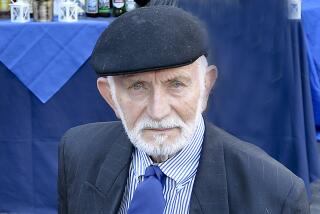The Contact Comes From 69,216 Feet, 6 Inches of Pounding
- Share via
Thom Hunt has this crazy idea that he is not involved in a contact sport.
I have this very sane conviction that he is wrong.
Hunt, you see, is a runner. Not a running back, mind you. A runner.
He probably theorizes that he does not have to dodge a Lyle Alzado or a Lawrence Taylor, so there is no contact in his line of endeavor.
He made this point Friday, when he was explaining that a stress fracture in a leg was rude enough to put him out of commission in the summer of 1984. Thus, he was not a party to the Olympic festivities.
“Running injuries,” he was saying, “are self-caused. Stress injuries are something you bring on yourself. You’re the one who’s moving your feet.”
It was not a matter of foolishly stepping on a palm frond or falling through an open manhole cover or hitting a parked car.
Hunt’s injury was caused by pounding. Miles and miles of pounding.
Football runners get hit by linebackers, but Hunt got hit by a planet. Or rather he hit a planet, over and over and over again.
How long has Thom Hunt been running competitively? Just about half of his 27 years. He started as a student at Patrick Henry High School, kept going at the University of Arizona and has not stopped since--except for that most important of years, the Olympic year.
And what caused the stress fracture which destroyed his Olympic hopes?
Hunt knows what, but not when.
“You can’t look back and say this one day I bagged it,” he said. “You can’t look back and pinpoint a day and say it might have been different if I hadn’t done this or that. I’m trying to be smarter about it now.”
It wasn’t one day, but rather all the days. Hunt’s training regimen, which he is more careful about these days, calls for 100 miles a week of running. And he’s trying to tell me this isn’t a contact sport? How often do his feet hit the ground in 100 miles?
Hunt’s next race will be Sunday’s America’s Finest City Half Marathon, which begins near the lighthouse on Cabrillo Point and ends in the Plaza de Panama in Balboa Park. According to my calculations, that is a distance of 69,216 feet and 6 inches.
That’s my idea of a lot of contact.
Remarkably, Hunt has never before been an entry in the AFC Half Marathon. He has always been occupied elsewhere. However, he does know the course.
“I’ve run almost all of it at one point or another,” he said. “Point Loma. Harbor Drive. The Sixth Street hill. I run Sixth Street a few times a week.”
I walk the Sixth Street hill twice a day, once down and the other up. I know how grueling that hill can be. I have come to warily approach the uphill journey, like a batter stepping to the plate against Dwight Gooden.
Indeed, Hunt himself tends to personalize the course he is up against--if he thinks the course has any personality. And, he said, the AFC Half Marathon course does have a personality.
“It has that major downhill early,” he said, “and then the long flat stretch. It tends to be fast early, but you can’t forget you’ve got to have something left for the uphill at the end.”
It sure sounds like a lot of fun to me, taking 11 miles of pounding and then hitting the uphill stretch. I think it’s tough hitting that hill after stepping off an elevator.
If that kind of a course was a person, it would be one of those nymphs who lured sailors to their islands with sultry singing and then watched as the poor blokes crashed on the rocks.
However, we have already established that runners seem to have a different perspective on life.
Hunt, for example, really thinks all that pounding is fun.
“I love what I’m doing,” he said. “Every run is different and there’s always a fresh challenge. You might enter the same race two years in a row, but even the same race will be different.”
Along the way, Hunt has left challenges for others in his wake. In fact, he still has the indoor high school record for the mile with a time of 4:02.7 at the Sports Arena in 1976.
“It’s kind of fun,” he said. “Records don’t usually last that long. I set an American record for 10,000 meters in 1981 and it didn’t last the year.”
There are, of course, other challenges for Hunt. Sunday’s race is a tune-up for the Twin Cities Marathon on Oct. 6. And there will be other marathons and half marathons and 10Ks and miles. More miles and more pounding and more contact in these non-contact events.
Maybe there will even be an Olympic appearance by Thom Hunt in 1988.
“I’ll be around,” he said. “I’ve got a lot of years left to run. I’m considered young in my sport.”
If that is what he chooses to believe, it is fine with me. I’d rather get hit by Fred Dean than run 69,216 feet and 6 inches. That’s my idea of a three-day hike, not a one-hour athletic event.
More to Read
Go beyond the scoreboard
Get the latest on L.A.'s teams in the daily Sports Report newsletter.
You may occasionally receive promotional content from the Los Angeles Times.






